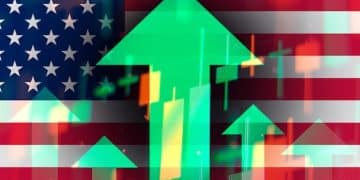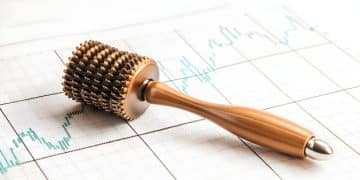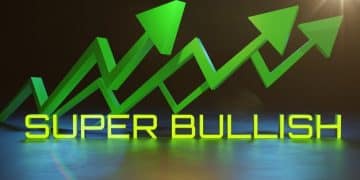Economic Indicators: Your Guide to Spotting Recession Signals
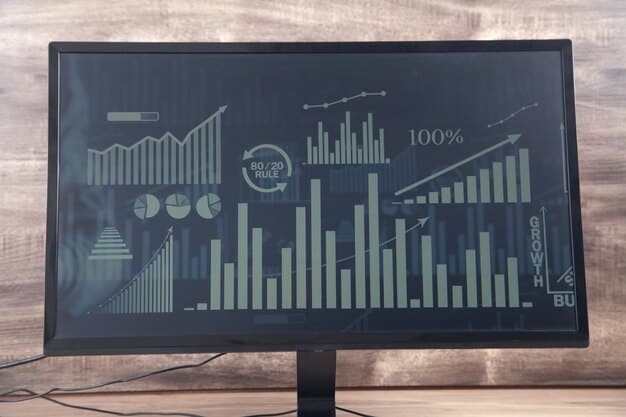
Navigating the complex landscape of economic shifts requires a keen understanding of key indicators, which serve as crucial signals for identifying potential recessionary trends and informing strategic financial decisions.
Understanding the intricate world of finance can often feel like deciphering a secret code. Yet, for investors, policymakers, and everyday citizens alike, the ability to interpret economic signals is paramount, particularly when assessing the health of our financial systems. This guide aims to demystify complex concepts, empowering you to better recognize the crucial Economic Indicators to Watch: A Guide to Understanding the Signals of a Recession.
Decoding the Economic Landscape: An Introduction to Indicators
The global economy is a vast, interconnected system, constantly in flux. Like a ship navigating stormy seas, its trajectory is influenced by countless forces, both seen and unseen. To comprehend its direction, economists and analysts rely on a suite of data points known as economic indicators.
These indicators are essentially statistical data that provide insights into economic activities. They can be broadly categorized as leading, lagging, or coincident, each offering a unique perspective on the economy’s current state and potential future path. Understanding these distinctions is fundamental to discerning whether the economy is merely slowing down or inching closer to a full-blown recession.
Leading Indicators: Glimpsing the Future
Leading indicators are perhaps the most anticipated, as they tend to change before the economy as a whole does. They are like the faint alarm bells or early warning signs that can help predict future economic movements, including potential downturns. While not infallible, a consistent trend in these indicators can provide valuable foresight.
- 📈 Stock Market Performance: Often seen as a forward-looking barometer, a sustained decline can reflect investor pessimism about future corporate earnings and economic growth.
- 🏗️ Building Permits: A dip in new construction permits often signals a slowdown in future construction activity, reflecting reduced confidence in demand and investment.
- 📊 Yield Curve Inversion: A highly debated but historically reliable indicator where short-term government bond yields exceed long-term yields, suggesting investor expectations of future economic weakness.
- 💼 Consumer Confidence Index: Measures how optimistic consumers are about the state of the economy. A significant drop can presage lower spending and investment.
Monitoring leading indicators provides an advantage, allowing for proactive measures rather than reactive responses. However, it’s crucial to remember that no single indicator provides a definitive answer; instead, it’s the confluence and sustained trends across multiple indicators that paint a more accurate picture.
Lagging Indicators: Confirming the Narrative
In contrast to leading indicators, lagging indicators react after the economic change has already occurred. They serve to confirm or deny the trends initially suggested by leading indicators, providing historical context and validating economic shifts. While they don’t predict, they offer crucial proof points.
- 📉 Unemployment Rate: Typically rises after a recession has begun and remains elevated even after initial recovery, confirming the severity of the downturn.
- 💸 Corporate Profits: Profits usually decline during recessions as consumer demand falls and remains low until recovery is well underway.
- 💰 Interest Rates (Prime Rate): Often adjusted by central banks in response to economic conditions, these changes reflect prior economic shifts.
Lagging indicators are essential for verifying the depth and duration of economic cycles. They help in understanding the full impact of an economic event and guide policy decisions that address the aftermath of a recession rather than preventing it.
The interplay between leading and lagging indicators is complex, yet insightful. Leading indicators offer a glimpse into what might be coming, while lagging indicators confirm what has already unfolded. Together, they form a comprehensive framework for understanding the dynamic nature of economic cycles, equipping us with the tools to navigate potential storms with more informed decisions.
Key Indicators to Monitor for Recession Signals
While a multitude of economic indicators exist, some are particularly potent in signaling potential recessionary trends. Focusing on these key metrics provides a more streamlined and effective approach to economic monitoring.
These indicators provide a foundational understanding of the macroeconomy, offering clues about consumer behavior, business investment, and the overall health of the labor market. Their movements, especially when they show sustained negative trends, often precede periods of economic contraction.
Gross Domestic Product (GDP): The Economy’s Pulse
Gross Domestic Product (GDP) is arguably the most comprehensive measure of a country’s economic activity. It represents the total monetary value of all finished goods and services produced within a country’s borders in a specific time period. A recession is officially defined, in many contexts, as two consecutive quarters of negative GDP growth.
- 📉 Sustained Decline: A prolonged period of shrinking GDP is a clear and direct indicator of economic contraction and a strong sign of recession.
- 📊 Sectoral Weakness: Analyzing GDP by sector can reveal specific areas of economic vulnerability, providing deeper insights into the nature of a slowdown.
While GDP is retrospective, revisions can occur, and its strength as a definitive measure of economic output makes it indispensable. A significant and consistent drop signals widespread economic distress, impacting businesses and households alike, making it a primary metric for assessing recessionary conditions.
The Labor Market: A Bellwether of Economic Health
The health of the labor market is a critical indicator of economic well-being. Employment levels, wage growth, and unemployment claims offer immediate insights into consumer purchasing power and business confidence.
When businesses anticipate a slowdown, they often reduce hiring or, in more severe cases, begin layoffs. This directly impacts household income and confidence, leading to a reduction in consumer spending, which forms a significant portion of economic activity.

Unemployment Rate and Initial Jobless Claims
The unemployment rate measures the percentage of the total labor force that is unemployed but actively seeking employment. While it’s a lagging indicator, a rapid and sustained increase signals widespread job losses and economic distress.
- 📈 Sharp Increase: A sudden and significant spike in the unemployment rate often confirms that the economy has entered or is deepening into a recession.
Initial jobless claims, however, are a leading indicator. They measure the number of people filing for unemployment benefits for the first time. A consistent rise in these claims suggests that employers are starting to shed jobs, indicating increasing economic weakness.
- ⚠️ Consistent Rise: A steady, week-over-week increase in initial jobless claims is an early warning sign that the labor market is deteriorating, often preceding a recession.
Together, these two labor market indicators provide a comprehensive picture of employment trends, offering both foresight and confirmation of economic shifts. Their movement is closely watched by economists and policymakers for early signs of trouble.
The state of the labor market, as reflected by the unemployment rate and jobless claims, exerts a profound influence on economic stability. A robust job market fuels consumer spending and investment, while weakness quickly translates into reduced demand and a broader economic slowdown, highlighting its crucial role in signaling a recession.
Consumer Spending and Confidence: The Engine of Growth
Consumer spending constitutes a substantial portion of economic activity in many developed nations. Therefore, monitoring its trends and the underlying consumer confidence is paramount to forecasting economic health. When consumers feel uncertain about their financial future or the broader economy, they tend to reduce discretionary spending, which can quickly cascade into a broader economic downturn.
Changes in consumer spending patterns can reflect shifts in income, employment prospects, and perceived financial security. A decline in spending can lead to reduced corporate profits, layoffs, and further dampen economic activity, creating a vicious cycle that can accelerate a recessionary environment.
Retail Sales: A Snapshot of Spending Habits
Retail sales measure the total receipts of retail establishments. This indicator provides a snapshot of consumer demand for goods. A sustained decline in retail sales often precedes broader economic contractions, as it reflects a pullback in consumer purchasing.
- 📉 Consistent Decline: A multi-month decline in retail sales, particularly across a broad range of sectors, suggests weakening consumer demand.
- 🛍️ Discretionary vs. Essential: Analyzing whether the decline is more pronounced in discretionary items (e.g., electronics, furniture) versus essentials (e.g., groceries) can provide insights into the severity of consumer anxiety.
The retail sales report is often seen as a leading indicator of consumer appetite and overall economic strength. Its trends are keenly observed for signs of weakening demand that could signal an impending economic contraction.
Consumer Confidence Index: Gauging Public Sentiment
The Consumer Confidence Index (CCI), as compiled by organizations like the Conference Board, measures the optimism of consumers regarding the state of the economy. It surveys consumer views on current business conditions, employment conditions, and their income expectations for the next six months.
- 😟 Sharp Drop: A significant and continued decline in the CCI suggests that consumers are becoming increasingly pessimistic about their economic prospects, which often translates into reduced spending and investment.
- 🔮 Future Expectations: A pronounced deterioration in the “Expectations Index” component of the CCI can be a particularly strong leading indicator of future economic slowdowns.
While a single month’s fluctuation might not be alarming, a trend of decreasing consumer confidence over several months indicates a fundamental shift in public sentiment. This shift can prefigure a reduction in consumer spending, which is a major driver of economic growth, thus heightening the risk of a recession.
Understanding consumer behavior, as revealed by retail sales and confidence indices, provides invaluable clues about the economy’s direction. When the primary engine of growth—consumer spending—starts to sputter, it warrants close attention as a potential harbinger of recession. These indicators, when viewed in conjunction with others, help form a more complete picture of the economy’s underlying health.
Manufacturing and Industrial Production: The Productive Backbone
The manufacturing and industrial sectors are the productive backbone of many economies, responsible for creating the goods that propel commerce and innovation. Therefore, indicators related to these sectors offer crucial insights into the supply side of the economy and business investment. A slowdown here can ripple through the entire supply chain, impacting employment and consumer demand.
When factories produce less, it signals reduced demand or oversupply, and the impact extends beyond the factory floor. It affects raw material suppliers, logistics companies, and ultimately, employment levels, making these indicators vital for assessing the vulnerability of the economy to a downturn.
Industrial Production Index: Output and Capacity
The Industrial Production Index measures the total output of the manufacturing, mining, and electric and gas utility industries. It captures changes in real output and capacity
- 📉 Sustained Decline: A prolonged decrease in industrial production suggests falling demand for goods, indicating a broad economic contraction.
- 🏭 Capacity Utilization: A sharp fall in capacity utilization (the percentage of total production capacity being used) implies businesses are producing less due to weak demand, a classic sign of an upcoming slowdown.
A downward trend in industrial production reflects reduced business investment and lower consumer demand for goods. This can quickly translate into job losses in these sectors, further exacerbating an economic downturn and signaling a potential recession.
New Orders for Durable Goods: Investment Foresight
New orders for durable goods measures the value of new orders placed with manufacturers for long-lasting products, such as machinery, transportation equipment, and electronics. This is a highly significant indicator because these orders often involve substantial investments by businesses and consumers, reflecting future production intentions.
- ⚙️ Consistent Decline: A sustained decline in new orders for durable goods, especially for non-defense capital goods (a proxy for business investment), is a strong leading indicator of economic weakness.
- ✈️ Transportation Sector Impact: Significant drops in orders in the transportation sector (e.g., aircraft) can reflect broader economic uncertainty among businesses.
When businesses reduce their orders for new equipment and machinery, it signifies a lack of confidence in future economic conditions and reduced demand expectations. This caution can lead to lower factory output, fewer jobs, and a general slowdown across the industrial sector, thus serving as a potent pre-recession signal.
The health of the manufacturing and industrial sectors, as evidenced by industrial production and durable goods orders, provides tangible evidence of economic activity. Weakness in these areas can be a strong predictor of a broader economic contraction, making them essential indicators to watch for any signs of an impending recession.
Financial Market Indicators: Beyond the Stock Market
While the stock market often captures headlines, other financial market indicators offer deeper, more nuanced insights into the economy’s future. These indicators reflect market participants’ collective assessment of risk, uncertainty, and future economic growth, often moving before real economic data.
These metrics are particularly sensitive to investor sentiment and credit conditions, key factors that can accelerate or decelerate economic cycles. Understanding their movements can provide a critical edge in anticipating economic shifts far in advance of official data releases.
Credit Spreads: A Measure of Risk Appetite
Credit spreads measure the difference in yield between corporate bonds (which carry credit risk) and government bonds (considered risk-free). A widening credit spread indicates that investors are demanding a higher premium for corporate debt, reflecting increased perceived risk in the economy and potentially a reluctance to lend.
- ↔️ Widening Spreads: A significant widening of credit spreads suggests growing investor fear and concerns about corporate solvency, often preceding an economic downturn or recession.
- 🏦 Lending Environment: Widening spreads can lead to tighter lending conditions for businesses, making it harder for them to borrow, invest, and expand, further stifling economic growth.
When credit markets tighten, it acts as a drag on economic activity, impacting investment, hiring, and overall liquidity. Monitoring credit spreads can therefore provide an early warning sign of deteriorating economic conditions and a looming recession.
Yield Curve Inversion: A Historically Reliable Bellwether
An inverted yield curve occurs when the yields on short-term government T-bills (e.g., 3-month or 2-year) become higher than the yields on long-term government bonds (e.g., 10-year). This phenomenon is often viewed as one of the most reliable historical predictors of recessions.
- 📉 Short-Term Yields > Long-Term Yields: An inverted yield curve typically reflects market expectations of future economic slowdowns and lower long-term interest rates.
- 🔮 Recessionary Precursor: Historically, every recession in the U.S. over the past 50 years has been preceded by an inverted yield curve, though not every inversion has led to a recession immediately.
The inversion signals that bond investors anticipate future economic weakness and potentially lower interest rates as central banks respond to a slowdown. While the exact mechanism is debated, its consistent track record makes it an indicator closely watched by economists and financial professionals for signs of an approaching recession.
Beyond the daily fluctuations of the stock market, credit spreads and the yield curve offer a more profound view of the underlying financial health and market sentiment. Their signals, often subtle at first, can provide crucial foresight into the economic challenges ahead, making them indispensable components of any recession watch toolkit.
International Economic Context and Policy Responses
No economy operates in a vacuum, especially in an increasingly globalized world. International economic conditions can significantly impact domestic stability, and policy responses from central banks and governments play a crucial role in mitigating or exacerbating economic downturns. Understanding this broader context adds another layer to our analysis of recessionary signals.
Global trade, geopolitical events, and the monetary policies of major economic powers can create ripple effects that influence domestic indicators. Similarly, timely and effective policy responses are critical for managing economic shocks and steering economies back toward growth.
Global Trade and Geopolitical Events: External Pressures
Fluctuations in global trade volumes and the occurrence of significant geopolitical events (e.g., trade wars, conflicts, pandemics) can transmit economic shocks across borders. A slowdown in major global economies can reduce demand for exports, impacting domestic industries and employment.
- 🌐 Trade Volume Decline: A significant and sustained reduction in global trade volumes suggests a synchronized global slowdown, increasing the risk of domestic recession.
- 🕊️ Geopolitical Instability: Unforeseen events can disrupt supply chains, energy prices, and investor confidence, triggering economic uncertainty and potentially a downturn.
Monitoring global economic health and geopolitical developments is essential for a comprehensive understanding of domestic recession risks. External pressures can often ignite or intensify internal economic vulnerabilities, making an international perspective invaluable.
Monetary and Fiscal Policy Responses: The Toolkit for Stability
Central banks (like the Federal Reserve in the US) utilize monetary policy tools, such as interest rate adjustments and quantitative easing, to influence economic activity. Governments employ fiscal policy, including spending and taxation, to stimulate or cool down the economy. The nature and timing of these responses are critical during periods of economic stress.
- 🏦 Interest Rate Hikes: While intended to curb inflation, aggressive rate hikes can stifle economic growth and increase the likelihood of a recession.
- 💰 Stimulus Packages: Government spending on infrastructure, unemployment benefits, or tax cuts can provide a crucial economic boost during a downturn.
The actions of policymakers and their willingness to intervene and adapt their strategies are paramount in navigating economic challenges. Their decisions can either cushion the blow of a recession or, if poorly timed, worsen its effects, making policy responses a key area of observation.
Integrating international economic dynamics and understanding the spectrum of policy responses provides a holistic view of the economic landscape. Recessionary signals are rarely purely domestic phenomena; they are often intertwined with global events and the strategic actions taken by major economic actors to maintain stability, requiring a broad and informed perspective.
Putting It All Together: A Holistic View of Recessionary Signals
Understanding individual economic indicators is just the first step. The true art of economic forecasting and recession detection lies in synthesizing these diverse signals into a cohesive narrative. No single indicator provides a definitive answer; rather, it’s the convergence of multiple warning signs that paints a convincing picture of an impending economic downturn.
A holistic approach involves not only observing the raw data but also contextualizing it within the broader economic cycles, historical trends, and current geopolitical landscape. It requires patience, critical thinking, and an understanding that economic shifts unfold over time, not overnight.
The Interconnectedness of Indicators
Economic indicators are not isolated data points; they are deeply interconnected, each influencing and reflecting upon the others. For example, a decline in consumer confidence might lead to reduced retail sales, which in turn could impact industrial production and potentially lead to higher unemployment.
- 🔄 Feedback Loops: Recognize how a negative trend in one indicator can amplify challenges in another, creating a reinforcing cycle that accelerates a slowdown.
- 🧩 Pattern Recognition: Look for consistent patterns of deterioration across multiple leading indicators as the most reliable signs of an approaching recession.
Observing these feedback loops and recognizing consistent patterns across diverse indicators is crucial for building a strong, evidence-based assessment of economic health. It moves beyond isolated data points to reveal the underlying momentum of the economy.
Avoiding False Alarms and Overreactions
The economy is inherently cyclical, and minor fluctuations are a normal part of its rhythm. Not every dip in the stock market or rise in jobless claims signals an imminent recession. Overreactions to isolated data points can lead to poor decision-making.
It’s important to distinguish between temporary slowdowns or corrections and a genuine, sustained downturn. Look for trends, not just momentary spikes or drops, and consider the underlying causes of any shifts. Is it a seasonal adjustment, a one-off event, or a systemic change?
Furthermore, the time lag between an indicator signaling a potential recession and the actual onset of the recession can vary significantly. An inverted yield curve, for instance, might precede a recession by 6 to 18 months, allowing for preparation rather than panic.
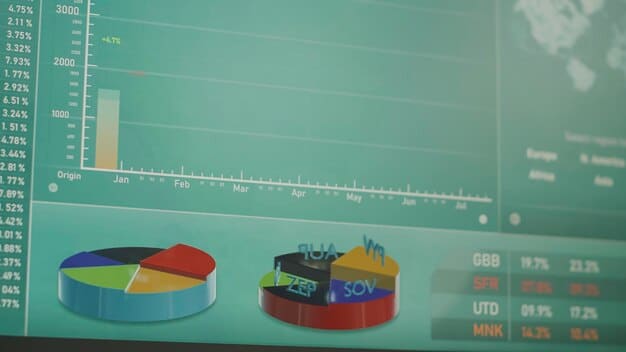
Ultimately, a disciplined and comprehensive approach to monitoring a diverse set of economic indicators, combined with a healthy skepticism towards single-point data and an understanding of economic cycles, provides the most robust framework for identifying potential recessionary signals and making informed decisions. It’s about preparedness, not alarmism; insight, not instinct.
| Key Indicator | Brief Description |
|---|---|
| 📈 GDP Decline | Two consecutive quarters of negative growth often signal a recession. |
| 💼 Jobless Claims Spike | A consistent rise in initial unemployment filings suggests a weakening labor market. |
| 😟 Consumer Confidence Drop | A significant fall indicates consumer pessimism and reduced spending intentions. |
| 📉 Yield Curve Inversion | Short-term bond yields exceeding long-term yields, a historically reliable recession predictor. |
Frequently Asked Questions About Economic Indicators and Recessions
An economic indicator is a piece of economic data, usually aggregate in nature, used by analysts to interpret current or future investment opportunities or to assess the overall health of an economy. These statistics can reveal trends, signal turning points, and help forecast economic conditions, including the potential for a recession.
Leading indicators change before the economy does, signaling future trends (e.g., building permits). Lagging indicators change after economic shifts, confirming patterns (e.g., unemployment rate). Coincident indicators move simultaneously with the economy, reflecting the present state (e.g., GDP).
While an inverted yield curve has historically preceded almost every U.S. recession over the past 50 years, it is not a guaranteed predictor. There can be a significant time lag between the inversion and the actual onset of a recession, and not every inversion leads to one immediately. It’s best viewed as a strong warning signal within a broader set of indicators.
Consumer confidence reflects public optimism about the economy and their financial situation. High confidence usually leads to increased spending and investment, fueling economic growth. Conversely, a sharp decline in confidence often results in reduced discretionary spending and saving, which can significantly dampen economic activity and contribute to a recession.
Central banks, like the U.S. Federal Reserve, implement monetary policy to stabilize the economy. During a recession, they typically lower interest rates to encourage borrowing and spending, or they may engage in quantitative easing to inject liquidity. These actions aim to stimulate demand, support financial markets, and mitigate the severity and duration of the economic downturn.
Conclusion: Empowering Your Economic Vigilance
Navigating the choppy waters of economic cycles demands more than just casual observation; it requires a systematic approach to understanding the subtle yet powerful messages conveyed by economic indicators. By diligently monitoring metrics ranging from GDP and labor statistics to consumer behavior and financial market signals, individuals and institutions can gain a clearer perspective on the economy’s trajectory. While no single indicator holds all the answers, their collective analysis provides an informed framework for anticipating recessions, fostering preparedness, and guiding smarter financial decisions in an ever-evolving economic landscape.

